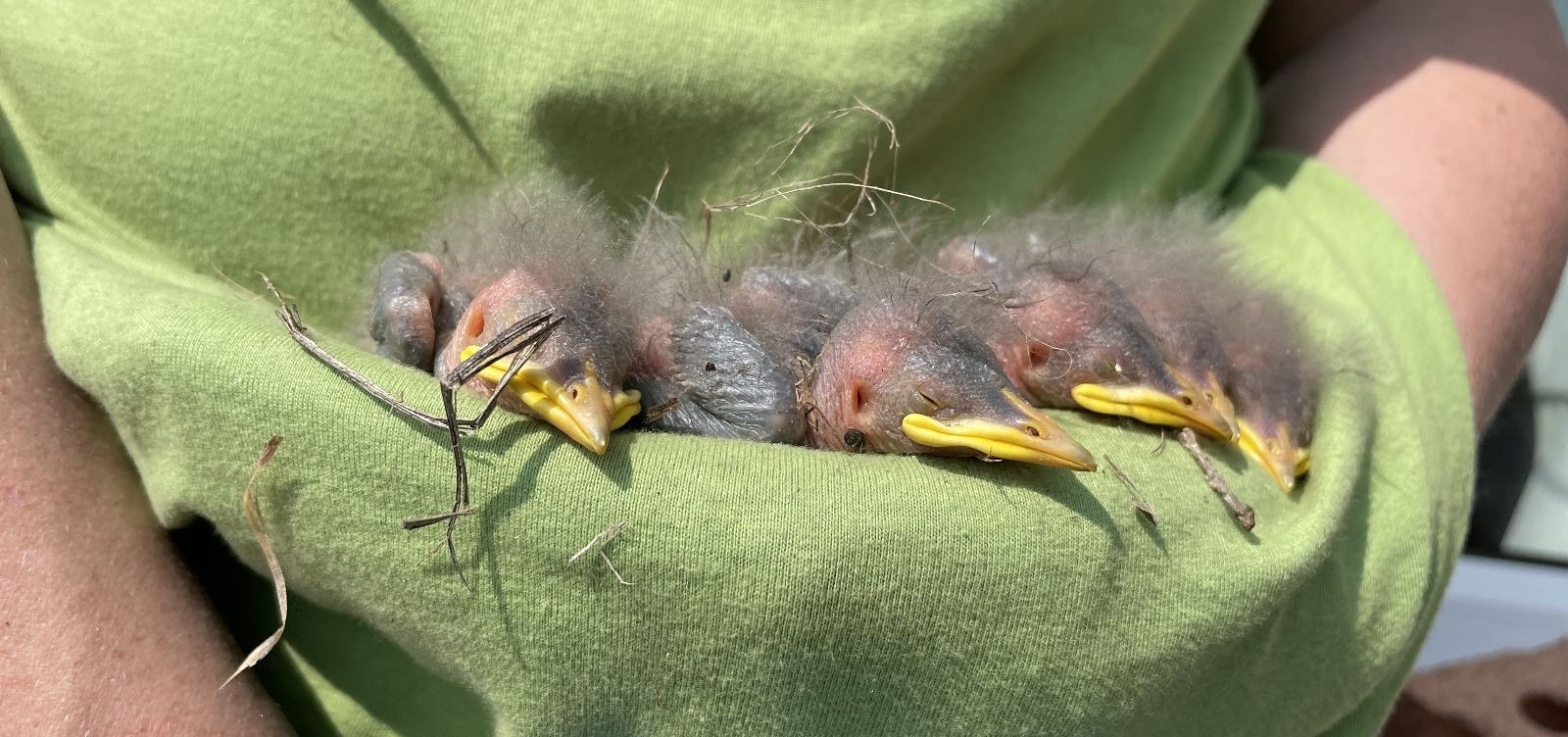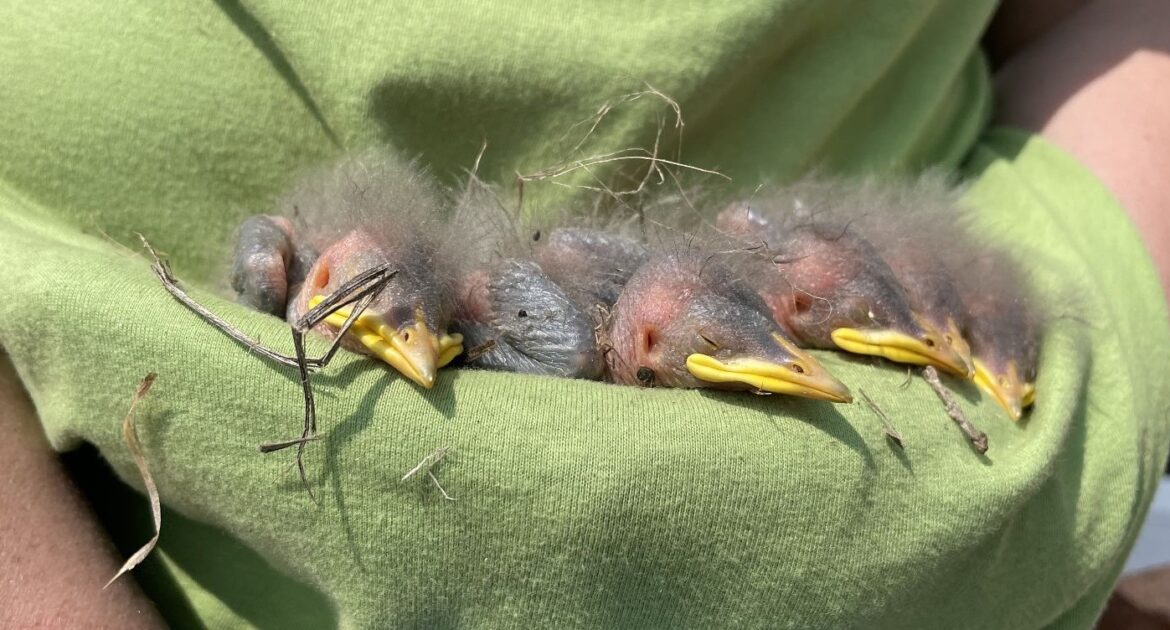If you’ve come across baby birds in your home or property, your first instinct might be to help or even move them. That’s a natural reaction, but knowing the right course of action is crucial for their safety and yours. Removing baby birds by hand without proper knowledge can harm these defenseless creatures and potentially create new hazards for your home. At Skedaddle Humane Wildlife Control, we’ve developed a humane and effective process for handling this delicate issue based on years of experience in Coon Rapids and throughout Anoka County.
In this guide, we will provide detailed baby bird removal tips, discuss the importance of handling baby birds safely, and highlight how our professional bird removal team ensures the welfare of both birds and homeowners.
Baby Bird Removal Tips
Removing baby birds safely begins with understanding their situation and needs. Whether you discover them nesting inside vents, attics, or on your property, rushing into action is never the solution. Here’s what you should know and do when you encounter baby birds.
1. Identify the Type of Bird and Its Nesting Cycle
Knowing the type of bird and its maturity is crucial. Some birds may simply be fledglings (partially grown with feathers, learning to fly), while others are nestlings (younger and entirely dependent on their parents). Nestlings should be left in the nest or carefully returned if displaced, while fledglings typically don’t need intervention as their parents are still nearby to care for them.
2. Check for Injuries or Immediate Danger
Look at the baby birds for signs of visible injuries like bleeding, broken wings, or shivering. If they seem physically harmed or if the parents are deceased, contact a licensed wildlife rehabilitator. Damaged nests, broken vents, or high-traffic areas near baby birds also require immediate attention.
3. Avoid Direct Handling
Do not pick up baby birds unless absolutely necessary, such as when they are in immediate danger or require moving to safety. Birds do not possess a strong sense of smell, contrary to popular belief, so placing them back in the nest typically does not cause rejection by their parents. Use gloves to minimize your contact, as birds can carry bacteria or parasites.
4. Understand the Legal Protections
Many species are protected under the Migratory Bird Treaty Act, making it illegal to move or disturb their nests in certain situations. Exceptions may apply for non-native species like starlings or house sparrows, but you should still contact professionals before proceeding.
5. Don’t Use DIY Solutions
Avoid attempting to resolve conflicts with wildlife using household or unapproved methods. These approaches can unintentionally harm the birds or worsen problems like clogged vents or hazardous nesting materials.
6. Call a Professional
For a thorough assessment and proper removal, enlist our trained technicians at Skedaddle. Professionals know how to handle each bird species safely and effectively, assessing areas like attics, vents, and chimneys to ensure baby birds are removed with care and no trace is left behind.
Handling Baby Birds Safely
Ensuring the safety of baby birds and maintaining your property’s condition requires a careful approach. At Skedaddle, we focus on humane practices to protect these young creatures while addressing potential health concerns and home hazards.
- Protective Equipment: Our team always uses gloves, masks, and other essential safety gear to handle baby birds and their nesting materials. Bird droppings can carry diseases like histoplasmosis, so proper cleaning is as important as removal.
- Temporary Nesting Solutions: For species like starlings found in vents, we gently remove the babies and create a substitute nesting container nearby, allowing the parent birds to continue caring for their young until they can fly. Once the chicks leave the temporary nest, we safely remove the structure and seal the vent.
- Inspection and Cleanup: Specialized tools enable us to reach vents, attics, and hard-to-access spaces to ensure no leftover materials pose risks. This cleanup prevents contaminants and reduces the chance of reinfestation.
- Species Assessment: Different birds require different care. For instance, pigeons may breed year-round, complicating their removal timeline, while sparrows often build nests in clusters. Our team plans each removal with these nuances in mind.
Why Professional Bird Removal Matters
Hiring a professional team like ours in Coon Rapids guarantees humane methods and long-term solutions. DIY attempts can leave baby birds vulnerable or damage your property. Here’s how Skedaddle handles bird removal with precision.
- Assessment: Skedaddle technicians identify the exact entry points baby birds are using and whether other parts of your property may also be impacted.
- Removal: We follow the proper timeline to ensure baby birds stay under their parents’ care whenever possible. Temporary nests and humane handling reduce stress for the birds while providing effective results.
- Cleaning and Prevention: Once the area is clear, we clean it thoroughly, removing hazardous nesting materials, droppings, and bacteria. We then close off entry points with durable materials to prevent birds from returning.
- Monitoring and Maintenance: After completing the removal and prevention process, we provide ongoing monitoring and maintenance services to ensure the effectiveness of our solutions. Regular inspections help identify any potential issues early and keep your property protected against future bird activity. Our team remains available to address concerns and offer professional support whenever needed.
- Customer Education and Support: We believe that informed customers are empowered customers. That’s why we provide detailed guidance on best practices to minimize bird activity around your property. This includes advice on maintaining clean and clutter-free areas, securing waste disposal, and addressing environmental factors that may attract birds. Additionally, our dedicated support team is always on hand to answer questions and provide reliable assistance, ensuring your property remains bird-free and well-protected.
Professional Bird Removal in Coon Rapids
Living in scenic Anoka County, we know how common encounters with wildlife can be. From springtime activity near the Coon Rapids Dam to housing developments, birds frequently nest in vents, roofs, and chimneys. While these visitors might seem harmless, they can create significant health and safety risks, especially when baby birds are involved. That’s where Skedaddle steps in to help.
Our hands-on methods are crafted with 30 years of expertise, ensuring every situation is handled with care and professionalism. Whether it’s a mother sparrow in your attic or starling chicks in a vent, we have the techniques and tools to keep your home safe while caring for its feathered occupants.
Your Call to Action
Don’t risk improper handling when baby birds make their way onto your property. Trust the experts at Skedaddle Humane Wildlife Control to provide humane, effective, and professional solutions to safeguard your home and the wildlife within.
Contact us today to learn more about our bird removal services in Coon Rapids and schedule your comprehensive assessment. Together, we’ll ensure a safe environment for you, your family, and the young birds you’ve encountered!




